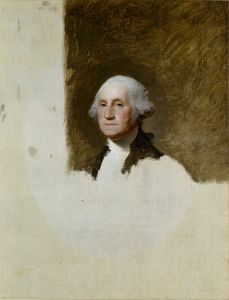Gideon Fairman was a blacksmith who developed an aptitude for engraving, and eventually chose to work on a reproduction of probably the best-known portrait in world history, Gilbert Stuart’s 1795 portrait of President Washington.
Fairman’s rendering of Stuart’s Washington has been reproduced at least 14 billion times since it first appeared on the US dollar bill in 1929. It finds its way onto T-shirts, chocolates and government web-sites. By all accounts it is taken from one of the worst likenesses of Washington ever produced: infinitely more human portraits of the President were done by the Philadelphia artist Rembrandt Peale. It was not really Gilbert Stuart’s fault that his picture worked out so pumpkin-like and expressionless. Stuart was first-rate: he had worked in London with the great progenitor of American painting, Benjamin West, and competed for sitters successfully against some of the giant names of British art.
Unfortunately for Stuart, Washington sat for him while he was trying to get used go a new set of false teeth, ‘clumsily formed of Sea-horse Ivory, to imitate both teeth and gums, [which] filled his mouth very uncomfortably…’ The president clapped them in every time he sat, hoping that they would grow more comfortable if he used them; in the end he abandoned them. ‘Mr Stuart himself told me that he never had painted a Man so difficult to engage in conversation, as was his custom, in order to elicit the natural expression, which can only be selected and caught in varied discourse. The teeth were at fault,’ explained Rembrandt Peale.
He might have enjoyed his innocent schadenfreude rather less had he known how the American public would always like this stiff, stubborn portrait, mutton-jaw and all. Stuart produced a total of three portraits of Washington and then, seeing how his bread was buttered, 111 replicas. In fact he lived off Washington’s face. Long before his portraits of the President appeared on the currency he lightly referred to them as his ‘one-hundred dollar bills.’
The original, so-called Athenaeum head was never finished; like its companion piece, a portrait of Martha Washington, it remains a sketch on oils and may be seen at the Boston Museum of Fine Arts.
An extract from my biography of the dollar, GREENBACK: The Almighty Dollar and the Invention of America.




